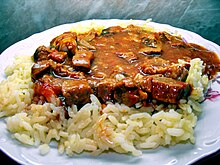
Back مطبخ بلغاري Arabic Bolqarıstan mətbəxi Azerbaijani Балгарская кухня Byelorussian Българска кухня Bulgarian Gastronomia de Bulgària Catalan Bulharská kuchyně Czech Bulgarische Küche German Gastronomía de Bulgaria Spanish آشپزی بلغاری Persian Cuisine bulgare French
| This article is part of a series on the |
| Culture of Bulgaria |
|---|
 |
| Society |
| Arts and literature |
| Other |
| Symbols |
|
Bulgaria portal |
| Part of a series on |
| Bulgarians Българи |
|---|
 |
| Culture |
| By country |
| Subgroups |
| Religion |
| Language |
| Other |

Bulgarian cuisine is part of the cuisine of Eastern Europe, sharing characteristics with other Balkan cuisines. Bulgarian cooking traditions are diverse because of geographical factors such as climatic conditions suitable for a variety of vegetables, herbs, and fruit. Aside from the variety of local Bulgarian dishes, Bulgarian cuisine shares a number of dishes with its neighboring countries, in particular with Turkish and Greek cuisine.[1]
Bulgarian cuisine includes a significant contribution from Ottoman cuisine,[2][3] and therefore shares a number of dishes with Middle Eastern cuisine, including moussaka,[4] gyuvetch, kyufte, baklava, ayran, and shish kebab.[5][6] Bulgarian food often incorporates salads as appetizers and is also noted for the prominence of dairy products, wines, and other alcoholic drinks such as rakia. The cuisine also features a variety of soups, such as the cold soup tarator, and pastries, such as the filo dough-based banitsa, pita, and the various types of börek.
Main courses are very typically water-based stews, either vegetarian or with lamb, goat meat, veal, chicken, or pork. Deep-frying is not common, but grilling—especially of different kinds of sausages—is prominent. Pork is common, often mixed with veal or lamb, although fish and chicken are also widely used. While most cattle are bred for milk production rather than meat, veal is popular for grilling meat appetizers (meze) and in some main courses. As a substantial exporter of lamb, Bulgaria's own consumption is notable, especially in the spring.[7]
Similar to other Balkan cultures, the per-capita consumption of yogurt (Bulgarian: кисело мляко, romanized: kiselo mlyako, lit. 'sour milk') among Bulgarians is traditionally higher than the rest of Europe. The country is notable as the historical namesake for Lactobacillus bulgaricus, a microorganism chiefly responsible for the local variety of dairy products.[8] Sirene (сирене), a white brine cheese similar to feta, is also a popular ingredient used in salads and a variety of pastries.
Holidays are often observed in conjunction with certain meals. On Christmas Eve, for instance, tradition requires vegetarian stuffed peppers and cabbage leaves sarmi. New Year's Eve usually involves cabbage dishes, Nikulden (Day of St. Nicholas, December 6) involves fish (usually carp), while Gergyovden (Day of St. George, May 6) is typically celebrated with roast lamb.
- ^ Еconomic.bg (2017-09-12). "История на традиционната българска кухня". Еconomic.bg (in Bulgarian). Retrieved 2023-10-24.
- ^ Stefan Detchev, "From Istanbul to Sarajevo via Belgrade—A Bulgarian Cookbook of 1874", doi:10.1163/9789004367548_015 in Earthly Delights: Economies and Cultures of Food in Ottoman and Danubian Europe, c. 1500–1900, 2018, Balkan Studies Library 23, ISBN 978-90-04-36754-8, p. 396
- ^ Iskra Velinova, "The Pleasures of Being Global: Cultural Consumption of Pizza and Sushi in a Bulgarian City", Approaching Consumer Culture, doi:10.1007/978-3-030-00226-8_8, p. 190
- ^ Cite error: The named reference
deutschwas invoked but never defined (see the help page). - ^ Culinary Cultures of Europe, ISBN 9789287157447, p. 98
- ^ A considerable number of dishes belonging to the "Bulgarian" cuisine are in fact borrowed from the Ottomans. Turkish cuisine forms the core of Balkan cuisine. For more see: Evgenia Krăsteva-Blagoeva, Tasting the Balkans: Food and Identity in Region, Regional Identity and Regionalism in Southeastern Europe, Part 2, Ethnologia Balkanica, Editors Klaus Roth, Ulf Brunnbauer, Lit Verlag, 2009, ISBN 3643101074, p. 33.
- ^ (April 2006). "Bulgaria Poultry and Products Meat Market Update." Thepoultrysite.com. Accessed July 2011.
- ^ "Bulgarians celebrate the art of 'true' homemade yoghurt". Timesofmalta.com. Retrieved 18 October 2017.